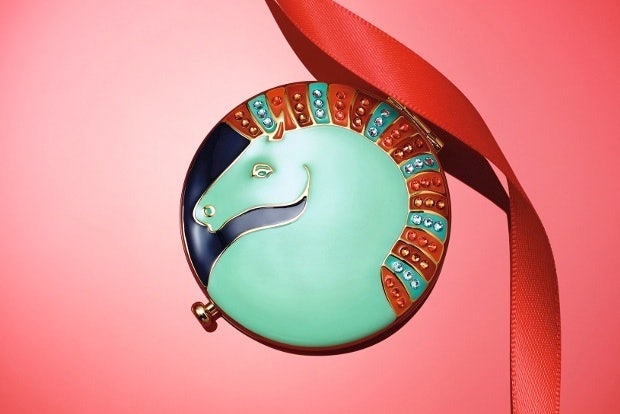
Estée Lauder's special-edition year of the horse compact.
Global beauty giant Estée Lauder made investors uneasy this week with a lackluster second-quarter earnings report, but is expressing high hopes that China’s lower-tier cities can boost its numbers by the end of the fiscal year.
In its recently released financial report, the company announced that slowing China growth, among other factors, has caused total second-quarter profits to slip by 3.4 percent. In addition, it lowered the high end of its revenue outlook from 7 percent to 6 percent, causing shareholders to feel skittish. The causes cited for this disappointing news included both weakness in Europe and the slowdown in China, but company CEO Fabrizio Freda expects China sales to pick up in the coming quarters as a result of the company’s push into second-, third-, and fourth-tier cities.
“The slowdown has been concentrated in Tier 1 cities, while the smaller cities are generating good growth,” said Freda on a conference call discussing the results yesterday.
The company’s Asia-Pacific growth declined 3 percent in local currency for the quarter, but net sales increased 5 percent. According to company CFO Tracey Thomas Travis, China growth hit 10 percent, adjusted for SMI, a lower number than the total six-month growth of 16 percent.

Supermodel Liu Wen in Estée Lauder's holiday 2013 ad campaign.
In order to boost these slowing numbers, Estée Lauder has been expanding its reach throughout China and “aggressively” building up its online presence, according to Freda. The company introduced its products to six new Tier 3 cities over the past fiscal quarter. The China slowdown has affected Tier 1 interest in luxury, “but in Tier 2, 3, 4 cities, meaning the new population on China now, the growing middle class now are approaching more prestige products; actually, the growth continued very solidly,” he said. “So we are adjusting our strategy to this new reality.”
Freda sounded optimistic about the China market, saying that since the lower-tier cities and online sales are rapidly growing, “the strategy is pretty simple. We are exposing our brands to the fastest-growing segments of the market. And thanks to that, we are able to continue growing above the market.”
On the e-commerce side, the brand has been building up its Tmall sales, and Clinique’s sales on the site have been “extremely successful,” said the CEO.
However, brand awareness is lower in Tier 2, 3, and 4 cities, making brick-and-mortar building a necessity. Building brand awareness in China also helps to boost the travel market as China’s middle class grows and more Chinese travelers head abroad. Freda cited travel retail sales as another reason for a domestic slowdown, stating that “the combination of our sales with the Chinese consumer is still very, very strong, even if there is this slowdown trend internally.”
In addition, the company has seen a pickup in sales prior to Chinese New Year, he said, which may have been boosted by the company's special-edition Chinese New Year compact for the year of the horse.